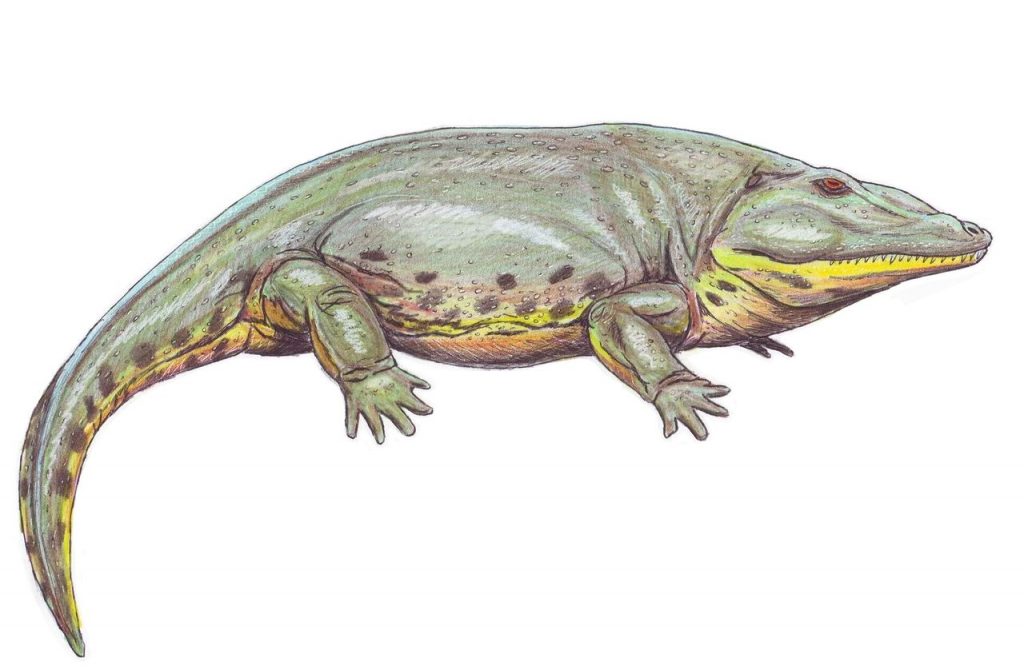Eryops, “Marshland Menace”
“Meet Eryops—the 10-foot-long, tooth-lined juggernaut of Permian swamps that crushes prey with a skull as wide as your shoulders!”
Across Early Permian floodplains, Eryops looms as a stocky, semi-aquatic giant, its 5–7-foot, barrel-chested body powered by stout, sprawling limbs that haul it through water and onto land.
Appearance
Eryops sports a massive, flattened skull over two feet wide, lined with stout, labyrinth-textured teeth built for gripping slippery prey. Its robust vertebrae and broad ribs form a stiff torso, while muscular limbs end in five sturdy digits, suggesting a purposeful, sprawling gait on land. The skin bears faint osteodermal nodules, offering light armor and a slightly rugged texture.
Behaviour
An ambush specialist, Eryops lies motionless at pond or stream edges, barely rippling the surface as it awaits unsuspecting fish or smaller amphibians. When prey wanders into range, it hurls its heavy head forward in a sudden, crushing bite, then drags victims ashore or into deeper water to drown.
Habitat
Fossil evidence places Eryops in warm, seasonally arid floodplain rivers and swamps of the Permian’s coastal plains. It favors shallow waterways fringed by driftwood and vegetation, where scattered pools persist through dry spells, allowing it to travel overland between feeding grounds.
Modus Operandi
- Stealth Lunge: Submerged just beneath the surface, it uses near-stillness to mask its approach.
- Powerful Bite: Its broad jaws clamp around prey, aided by interlocking teeth that prevent escape.
- Drag and Consume: Forelimbs heave the catch onto land or into deeper pools; small victims are swallowed whole, larger ones torn by vigorous head-shakes.
- Terrestrial Traverse: When water dries, Eryops trudges across land in a salamander-like crawl, seeking the next pond or stream.
Motivation
Eryops epitomizes the apex semi-aquatic predator—its massive size, armored body, and dual-mode locomotion evolved to dominate both aquatic prey and the patchwork of terrestrial refuges in a dynamic Permian landscape, ensuring its success and survival in challenging, fluctuating environments.
Eryops 5e
Eryops 3.5
Eryops
Large Beast, Unaligned
Armor Class 14 (Natural Armor)
Hit Points 102 (12d10 + 36)
Speed 30 ft., swim 30 ft.
| STR | DEX | CON | INT | WIS | CHA |
|---|---|---|---|---|---|
| 19 (+4) | 10 (+0) | 17 (+3) | 2 (−4) | 12 (+1) | 5 (−3) |
Saving Throws STR +7, CON +6
Skills Perception +3, Stealth +2
Senses Darkvision 60 ft., Passive Perception 13
Languages —
Challenge 5 (1,800 XP)
Proficiency Bonus +3
Amphibious Nature.
Eryops can breathe both air and water.
Hold Breath.
Eryops can hold its breath for up to 30 minutes.
Swamp Camouflage.
Eryops has advantage on Dexterity (Stealth) checks made to hide in swampy or aquatic terrain.
Actions
Multiattack.
It makes two attacks: one with its Bite and one with its Tail.
Bite. Melee Weapon Attack: +7 to hit, reach 5 ft., one target. Hit: 18 (2d10 + 4) piercing damage. If the target is a Medium or smaller creature, it must succeed on a DC 15 Strength saving throw or be grappled (escape DC 15). Until this grapple ends, the target is restrained, and Eryops can’t bite another target.
Tail. Melee Weapon Attack: +7 to hit, reach 10 ft., one target. Hit: 14 (2d8 + 4) bludgeoning damage. If the target is a creature, it must succeed on a DC 15 Strength saving throw or be knocked prone.
Swamp Ambush (Recharge 5–6).
While submerged in water or mud, Eryops can lunge up to 20 feet in a straight line without provoking opportunity attacks. If it ends this movement within 5 feet of a creature, it can make a Bite attack as a bonus action.
Tactics
Eryops prefers to lie in wait beneath the surface of murky waters, using its Swamp Camouflage to remain undetected. When prey approaches, it utilizes Swamp Ambush to close the distance rapidly, attempting to grapple with its powerful Bite. Once a creature is grappled, Eryops uses its Tail attack to knock away other threats or to prevent assistance to its prey. If overwhelmed, it retreats into the water, using its amphibious nature to escape terrestrial pursuers.

A powerful crocodilian creature bursts from the muddy water, grabbing your halfling friend right before your eyes. In a flash he and the beast are gone into the gloom again.
From the Permian period, these carnivores spent a bit more time out on dry land then their fellows did. They are thick bodied and their mouths are large and full of teeth.
Heavyset amphibians that dwell in the waters of various tropical regions, eryops are usually piscivores but will eat other things if the opportunity. They will on occasion group together to bask on the banks of their home.
Originally Posted by Raptorial of the Wizards Community forums.
| Eryops (Bigmouth) | |
| Large animal | |
| Hit Dice | 3d8+24 (37 hp) |
| Initiative | +3 (+3 Dexterity) |
| Speed | 10 ft. (2 squares), Swim 30 ft. (6 squares) |
| Armor Class | 14 (-1 size, +3 Dexterity, +2 natural), touch 12, flat-footed 11 |
| Base Attack/Grapple | +2/+14 |
| Attack | Bite +9 melee (1d8 +8) |
| Full Attack | Bite +9 melee (1d8 +8) and tail +4 melee (1d6 +4) |
| Space/Reach | 10 ft./5 ft. |
| Special Attacks | Improved grab, swallow whole |
| Special Qualities | Hold breath, Low-Light Vision |
| Saves | Fort +12, Ref +6, Will +1 |
| Abilities | Strength 27, Dexterity 16, Constitution 25, Intelligence 2, Wisdom 10, Charisma 8 |
| Skills | Hide +3, Listen +1, Spot +1, Swim +8 |
| Feats | Great Fortitude,Toughness |
| Environment | Warm marshes, rivers, lakes, or swamps |
| Organization | Solitary or basking column (3-11) |
| Challenge Rating | 3 |
| Treasure | None |
| Alignment | Always neutral |
| Advancement | 4-6 HD (Large); 7-9 HD (Huge) |
| Level Adjustment | – |
Combat
Eryops battle similar to crocodiles.
Improved Grab (Ex) If an eryops hits with its bite, it deals normal damage and attempts to start a grapple as a free action without provoking an attack of opportunity. No initial touch attack is required. Improved grab only works against creatures size Medium or smaller.
The eryops has the option to conduct the grapple normally, or simply use the part of its bite to hold the opponent. If it chooses to do the latter, it takes a -20 penalty on grapple checks, but is not considered grappled itself; the eryops does not lose its Dexterity bonus to AC, still threatens an area, and can use its remaining attacks against other opponents. Each successful grapple check it makes during successive rounds automatically deals the damage indicated for the attack that established the hold. This act does not provoke attacks of opportunity. It can even move (possibly carrying away the opponent), provided it can drag the opponent’s weight.
Swallow Whole (Ex) If an eryops begins its turn with an opponent held in its mouth (see Improved Grab), it can attempt a new grapple check (as though attempting to pin the opponent). If it succeeds, it swallows its prey, and the opponent takes bite damage. The eryops’ smaller throat capacity means that unlike most swallowers, it can only swallow whole a creature size Small or smaller.
A swallowed creature is considered to be grappled, while the creature that did the swallowing is not. Each round a swallowed creature gets 1d6 points of acid damage dealt to it from the eryops’ powerful digestive enzymes. A swallowed creature can try to cut its way free with any light slashing or piercing weapon (the amount of cutting damage required to get free is 20 HP, eryops have strong stomach linings), or it can just try to escape the grapple.
The Armor Class of the interior of an eryops is 10 + 1/2 its natural armor bonus, with no modifiers for size or Dexterity. If the swallowed creature escapes the grapple, success puts it back in the attacker’s mouth, where it may be bitten or swallowed again.
Hold Breath (Ex) An eryops may hold its breath for 1 hour + and number of minutes as the eryops’ Constitution bonus.

 Buy me a coffee
Buy me a coffee